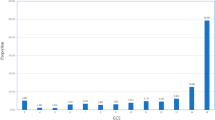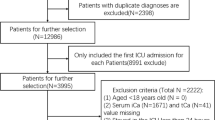Abstract
The aim of this study is to investigate whether there is a correlation between serum calcium levels and clinical severity or functional outcome at discharge in Chinese patients with acute ischemic stroke. Data from 339 patients admitted to our hospital between July 2020 and July 2021 were analyzed. Baseline demographic and clinical information was collected within 24 h of admission, including serum calcium levels, stroke severity (measured by the National Institutes of Health Stroke Scale [NIHSS] score), and lesion volumes. The modified Rankin Scale [mRS] assessed functional outcomes at discharge. Our analysis showed that the median age of patients included in the study was 65 years (interquartile range [IQR], 60–70), and 60.8% were men. We found a positive correlation between serum calcium levels and stroke severity (r[spearman] = 0.266, P < 0.001), with calcium levels increasing as stroke severity increased. In a subgroup of 188 patients with available MRI data, serum calcium concentrations positively correlated with infarct size. Furthermore, in multivariate analysis, a calcium serum level in the highest quartile was associated with a higher risk of unfavorable outcome (odds ratios [OR] = 3.27; 95% confidence intervals [CI] = 1.91–5.59; P < 0.001). In conclusion, our study indicates that higher calcium serum levels are associated with stroke severity and early neurologic outcome after acute ischemic stroke, indicating that calcium may serve as a prognostic biomarker for stroke in Chinese patients.







Similar content being viewed by others
Data availability
Please contact the author for data requests.
References
Johnson CO, Nguyen M, Roth GA, Nichols E, Alam T, Abate D, …, Miller TR (2019) Global, regional, and national burden of stroke, 1990–2016: a systematic analysis for the global burden of Disease Study 2016. Lancet Neurol 18(5):439–458
Tu W, Zhao Z, Yin P et al (2023) Estimated Burden of Stroke in China in 2020. JAMA Netw Open 6(3):e231455. https://doi.org/10.1001/jamanetworkopen.2023.1455
Wu S, Wu B, Liu M, Chen Z, Wang W, Anderson CS, …, Zhang S (2019) Stroke in China: advances and challenges in epidemiology, prevention, and management. Lancet Neurol 18(4):394–405
Tu WJ, Wang LD, on behalf of the Special Writing Group of China Stroke Surveillance Report (2023) China stroke surveillance report 2021. Military Med Res 10:33. https://doi.org/10.1186/s40779-023-00463-x
Tu WJ, Qiu HC, Liu YK, Liu Q, Zeng X, Zhao J (2020) Elevated levels of adiponectin associated with major adverse cardiovascular and cerebrovascular events and mortality risk in ischemic stroke. Cardiovasc Diabetol 19(1):1–13
Kristian T, Siesjo BK (1998) Calcium in ischemic cell death. 29:705–718
DeLorenzo RJ, Sun DA, Blair RE, Sombati S (2007) An in vitro model of stroke-induced epilepsy: elucidation of the roles of glutamate and calcium in the induction and maintenance of stroke-induced epileptogenesis. Int Rev Neurobiol 81:59–84
Iso H, Stampfer MJ, Manson JE, Rexrode K, Hennekens CH, Colditz GA, …, Willett WC (1999) Prospective study of calcium, potassium, and magnesium intake and risk of stroke in women. Stroke 30(9):1772–1779
Umesawa M, Iso H, Ishihara J, Saito I, Kokubo Y, Inoue M, Tsugane S (2008) Dietary calcium intake and risks of stroke, its subtypes, and coronary heart disease in japanese: the JPHC Study Cohort I. Stroke 39(9):2449–2456
Larsson SC, Orsini N, Wolk A (2013) Dietary calcium intake and risk of stroke: a dose-response meta-analysis. Am Clin Nutr 97(5):951–957
Li K, Kaaks R, Linseisen J, Rohrmann S (2012) Associations of dietary calcium intake and calcium supplementation with myocardial infarction and stroke risk and overall cardiovascular mortality in the Heidelberg cohort of the european prospective investigation into Cancer and Nutrition study (EPIC-Heidelberg). Heart 98(12):920–925
Chung JW, Ryu WS, Kim BJ, Yoon BW (2015) Elevated calcium after acute ischemic stroke: association with a poor short-term outcome and long-term mortality. J stroke 17(1):54–59
Buck BH, Liebeskind DS, Saver JL, Bang OY, Starkman S, Ali LK, …, Ovbiagele B (2007) Association of higher serum calcium levels with smaller infarct volumes in acute ischemic stroke. Arch Neurol 64(9):1287–1291
Ovbiagele B, Liebeskind DS, Starkman S, Sanossian N, Kim D, Razinia T, Saver JL (2006) Are elevated admission calcium levels associated with better outcomes after ischemic stroke? Neurology 67(1):170–173
Hatano S (1976) Experience from a multicentre stroke register: a preliminary report. Bull World Health Organ 54:541–553
Adams HP Jr, Bendixen BH, Kappelle LJ, Biller J, Love BB, Gordon DL et al (1993) Classification of subtype of acute ischemic stroke. Definitions for use in a multicenter clinical trial. TOAST. Trial of Org 10172 in Acute Stroke Treatment. Stroke 24:35–41
Brott T, Marler JR, Olinger CP et al (1989) Measurements of acute cerebral infarction: lesion size by computed tomography. Stroke 20:871–875
Katan M, Fluri F, Morgenthaler NG, Schuetz P, Zweifel C, Bingisser R, Müller K, Meckel S, Gass A, Kappos L, Steck AJ, Engelter ST, Müller B, Christ-Crain M (2009) Copeptin: a novel, independent prognostic marker in patients with ischemic stroke. Ann Neurol 66(6):799–808
Bonita RBR (1988) Modification of Rankin Scale: recovery of motor function after stroke. Stroke 19:1497–1500
Tu WJ, Qiu HC, Zhang Y, Cao JL, Wang H, Zhao JZ, …, Zeng X (2019) Lower serum retinoic acid level for prediction of higher risk of mortality in ischemic stroke. Neurology 92(15):e1678–e1687
Zhang JF, Meng X, Jing J, Pan Y, Wang YL, Zhao XQ, …, Wang YJ (2021) Serum calcium and outcome after ischemic stroke: results from the China National stroke registry III. Atherosclerosis 325:24–29
Appel SA, Molshatzki N, Schwammenthal Y, Merzeliak O, Toashi M, Sela BA, Tanne D (2011) Serum calcium levels and long-term mortality in patients with acute stroke. Cerebrovasc Dis 31(1):93–99
Obisesan OH, Osei AD, Berman D, Dardari ZA, Uddin SI, Dzaye O, …, Blaha MJ (2021) Thoracic aortic calcium for the prediction of stroke mortality (from the coronary artery Calcium Consortium). Am J Cardiol 148:16–21
Guven H, Çilliler AE, Koker C, Sarikaya SA, Comoglu SS (2011) Association of serum calcium levels with clinical severity of acute ischemic stroke. Acta Neurol Belgica 111(1):45–49
Ishfaq M, Ullah F, Akbar S, Rahim F, Afridi AK (2017) Correlation of serum calcium with severity of acute ischaemic stroke. J Pak Med Assoc 67(2):3–10
Borah M, Dhar S, Gogoi DM, Ruram AA (2016) Association of serum calcium levels with infarct size in acute ischemic stroke: observations from Northeast India. J neurosciences rural Pract 7(01):S041–S045
Inoue Y, Miyashita F, Toyoda K, Minematsu K (2013) Low serum calcium levels contribute to larger hematoma volume in acute intracerebral hemorrhage. Stroke 44(7):2004–2006
Mao J, Jiang W, Liu G, Jiang B (2019) Serum calcium levels at admission is associated with the outcomes in patients with hypertensive intracerebral hemorrhage. Br J Neurosurg 33(2):145–148
Guo Y, Yan S, Zhang S, Zhang X, Chen Q, Liu K, …, Lou M (2015) Lower serum calcium level is associated with hemorrhagic transformation after thrombolysis. Stroke 46(5):1359–1361
Gupta A, Prabhakar S, Modi M, Bhadada SK, Kalaivani M, Lal V, Khurana D (2016) Effect of vitamin D and calcium supplementation on ischaemic stroke outcome: a randomised controlled open-label trial. Int J Clin Pract 70(9):764–770
Zhu HL, Liu Y, Zhang J, Wang MX, Jiang H, Guo F, …, Ma L (2021) Dietary calcium, magnesium, and phosphorus intakes and risk of stroke in chinese adults. Sci Rep 11(1):1–9
Dibaba DT, Xun P, Fly AD, Bidulescu A, Tsinovoi CL, Judd SE, …, He K (2019) Calcium intake and serum calcium level in relation to the risk of ischemic stroke: findings from the REGARDS Study. J stroke 21(3):312
Larsson SC, Traylor M, Burgess S, Boncoraglio GB, Jern C, Michaëlsson K, MEGASTROKE project of the International Stroke Genetics Consortium (2019) Serum magnesium and calcium levels in relation to ischemic stroke: mendelian randomization study. Neurology 92(9):e944–e950
Kristián T (2004) Metabolic stages, mitochondria and calcium in hypoxic/ischemic brain damage. Cell Calcium 36(3–4):221–233
Kristián T, Siesjö BK (1998) Calcium in ischemic cell death. Stroke 29(3):705–718
Nicholls DG (1985) A role for the mitochondrion in the protection of cells against calcium overload? Prog Brain Res 63:97–106
Chen W, Huang J, Hu Y, Khoshnam SE, Sarkaki A (2020) Mitochondrial transfer as a therapeutic strategy against ischemic stroke. Translational Stroke Research, 1–15
Liu F, Lu J, Manaenko A, Tang J, Hu Q (2018) Mitochondria in ischemic stroke: new insight and implications. Aging and disease 9(5):924–937
Zoratti M, Szabo I (1995) The mitochondrial permeability transition. Biochim Biophys Acta 1241:139–176
Rajkovic O, Gourmel C, d’Arcy R, Wong R, Rajkovic I, Tirelli N, Pinteaux E (2019) Reactive oxygen species-responsive nanoparticles for the treatment of ischemic stroke. Adv Ther 2(7):1900038
Nash KM, Schiefer IT, Shah ZA (2018) Development of a reactive oxygen species-sensitive nitric oxide synthase inhibitor for the treatment of ischemic stroke. Free Radic Biol Med 115:395–404
Gelmers HJ, Gorter K, de Weerdt CJ, Wiezer HJ (1988) A controlled trial of nimodipine in acute ischemic stroke. N Engl J Med 318:203–207
Mohr JP, Orgogozo JM, Harrison MJG, Hennerici M, Wahlgren NG, Gelmers JH et al (1994) Meta-analysis of oral nimodipine trials in acute ischemic stroke. Cerebrovasc Dis 4:194–196
Zhang J, Liu J, Li D, Zhang C, Liu M (2019) Calcium antagonists for acute ischemic stroke. Cochrane Database of Systematic Reviews. 2https://doi.org/10.1002/14651858.CD001928.pub3
Horn J, Limburg M (2001) Calcium antagonists for ischemic stroke: a systematic review. Stroke 32(2):570–576
Ovbiagele B, Starkman S, Teal P, Lyden P, Kaste M, Davis SM, …, Saver JL (2008) Serum calcium as prognosticator in ischemic stroke. Stroke 39(8):2231–2236
Theodoratou E, Tzoulaki I, Zgaga L, Ioannidis JP (2014) Vitamin D and multiple health outcomes: umbrella review of systematic reviews and meta-analyses of observational studies and randomised trials.BMJ. 348:g2035. https://doi.org/10.1136/bmj.g2035
Berghout BP, Fani L, Heshmatollah A, Koudstaal PJ, Ikram MA, Zillikens MC, Ikram MK (2019) Vitamin D status and risk of stroke: the rotterdam study. Stroke 50(9):2293–2298
Tu WJ, Zhao SJ, Xu DJ, Chen H (2014) Serum 25-hydroxyvitamin D predicts the short-term outcomes of chinese patients with acute ischaemic stroke. Clin Sci 126(5):339–346
He W, Ruan Y (2022) Poor sleep quality, vitamin D deficiency and depression in the stroke population: a cohort study. J Affect Disord 308:199–204
Zhang J, Liu J, Li D, Zhang C, Liu M (2019) Calcium antagonists for acute ischemic stroke. Cochrane Database Syst Rev 2(2):CD001928
de Abajo FJ, Rodríguez-Martín S, Rodríguez-Miguel A, Gil MJ (2017) Risk of ischemic stroke Associated with Calcium supplements with or without vitamin D: a nested case-control study. J Am Heart Assoc 6(5):e005795
Acknowledgements
All authors have contributed significantly and agreed with the content of the manuscript. We are grateful to all the people who participated in our study.
Funding
None.
Author information
Authors and Affiliations
Contributions
Chen X had full access to all of the data in the study and took responsibility for the integrity of the data and the accuracy of the data analysis. Study concept and design: All authors; Acquisition of data: Zhang Y, Zhang G; Analysis and interpretation of data: Zhang Y, Chen X; Drafting of the manuscript: Zhang Y, Zhang G; Critical revision of the manuscript for important intellectual content: Chen X; Administrative, technical, or material support: All authors; Study supervision: Chen X. All authors read and approved the final manuscript.
Corresponding author
Ethics declarations
Ethics approval and consent to participate
Written informed consent was obtained from all patients, and this study conformed to the principles of the Declaration of Helsinki and was approved by the Ethics Committee of the Weifang People’s Hospital.
Consent for publication
None.
Competing interests
None.
Additional information
Publisher’s Note
Springer Nature remains neutral with regard to jurisdictional claims in published maps and institutional affiliations.
Rights and permissions
Springer Nature or its licensor (e.g. a society or other partner) holds exclusive rights to this article under a publishing agreement with the author(s) or other rightsholder(s); author self-archiving of the accepted manuscript version of this article is solely governed by the terms of such publishing agreement and applicable law.
About this article
Cite this article
Zhang, Y., Zhang, G. & Chen, X. Elevated Calcium after Acute Ischemic Stroke Predicts Severity and Prognosis. Mol Neurobiol 61, 266–275 (2024). https://doi.org/10.1007/s12035-023-03581-8
Received:
Accepted:
Published:
Issue Date:
DOI: https://doi.org/10.1007/s12035-023-03581-8




